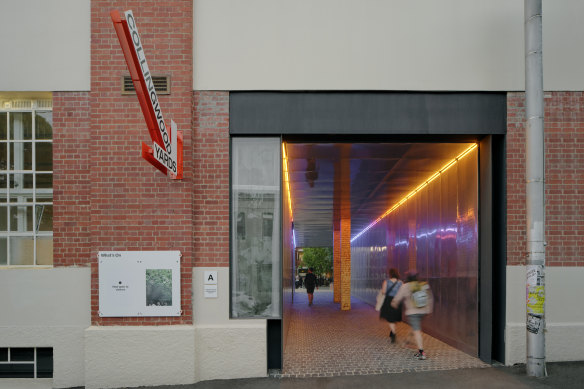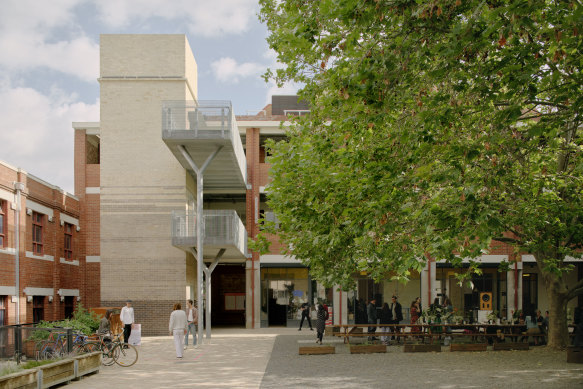This was published 3 years ago
Art deco Collingwood Yards attracts creative types
By Stephen Crafti
With increasing rents, particularly in the inner city, studio spaces are becoming difficult to both find and afford.
So, the arrival of Collingwood Yards in Johnston Street, former home to Collingwood TAFE, is a welcome addition to the neighbourhood.

Collingwood Yards.Credit: Tom Ross
Originally built in the interwar period in the art deco style and recently transformed by Fieldwork Architects (via a design competition), this precinct has become home to a broad group of creatives including the West Space Gallery, Uro Bookshop and a pottery studio, along with cafes and meeting areas, both indoors and out.
There are also music studios, a recording studio for PBS radio station and a couple of craft outlets.
And while the original buildings, along with Keith Haring’s mural, remain intact, there’s now a more seamless connection between buildings and trajectories of pathways that lead through the precinct to Perry Street at the rear of this site.
Architect Quino Holland, director of Fieldwork Architects, worked closely with Daniel Besen, a primary patron and founding chair of the Collingwood Yards board, together with Marcus Westbury, former CEO of Collingwood Yards, and numerous creatives such as landscape architects SBLA Studio.
“The kernel of the idea came from the buildings. It just seemed like the natural place to create an artistic community and, importantly, engage with the neighbourhood,” says Besen, who was also inspired by Mana Contemporary, a similar development in New Jersey.
“We won the design competition about six years ago, with our main concerns being transforming what was an abandoned school into a vibrant arts hub.
“From the outset, we didn’t want to damage the precious facade, with its distinctive detailing,” says Holland, whose presentation to the board was a book compiled with leading graphic designer Stuart Geddes, who formerly occupied a studio adjacent to the Yards.

The well-protected gravel courtyard, shaded by the dense planting of plane trees.Credit: om Ross
For many architects, the opportunity to refurbish older buildings often comes with new lifts and staircases discretely placed within the building’s original fabric.
However, in this instance, new staircases and lifts have been deliberately placed externally.
The new lifts are constructed in similar pale bricks as used in the 1930s, treated almost as separate additions.
Likewise, the steel staircases, with their tree-like structural columns, skim the original bricks and create their own graphic architectural expression.
“We wanted people to freely navigate the spaces, rather than feeling tunnelled in following one direction,” says Holland.
One of the major decisions made by Fieldwork and supported by the board and those involved, was not to take the obvious path of creating the point of arrival through the original art deco embellished portico.
“We felt that it was important to open up the Yards to the wider community, making it as accessible as possible,” says Holland.
The alternative option, and the one that proceeded, was to locate the main entrance along the western edge of Johnston Street.
This leads directly to the well-protected gravel courtyard, shaded by the dense planting of plane trees.
The new entrance, wrapped in stainless-steel panels and featuring a cobbled bluestone pathway, allows for unimpeded sight lines.
“Using the original entrance would have led to a blank wall of the back of a building,” says Holland.
Central to this new entrance are two brick pillars, part of the original structure and now clad in gold leaf.
“We saw these pillars, like the new lifts and staircases, as sculptural objects, as well as being functional necessities to make this precinct work,” says Holland, pointing out a new cobbled lane to the rear that also provides a protective undercroft used in more inclement weather.
Other areas, such as balconies that wrap around the studios, were also opened up with rudimentary glass windows removed.
Collingwood Yards has become an important creative hub for Melbourne.
There are now numerous amenities including a rooftop bar/garden and studios and galleries to explore – more than 50 in total.
The past has also been carefully restored, but instead of posters plastered to the stucco concrete walls, there are framed information sheets of upcoming events.
Best of all, it feels enmeshed in the neighbourhood.